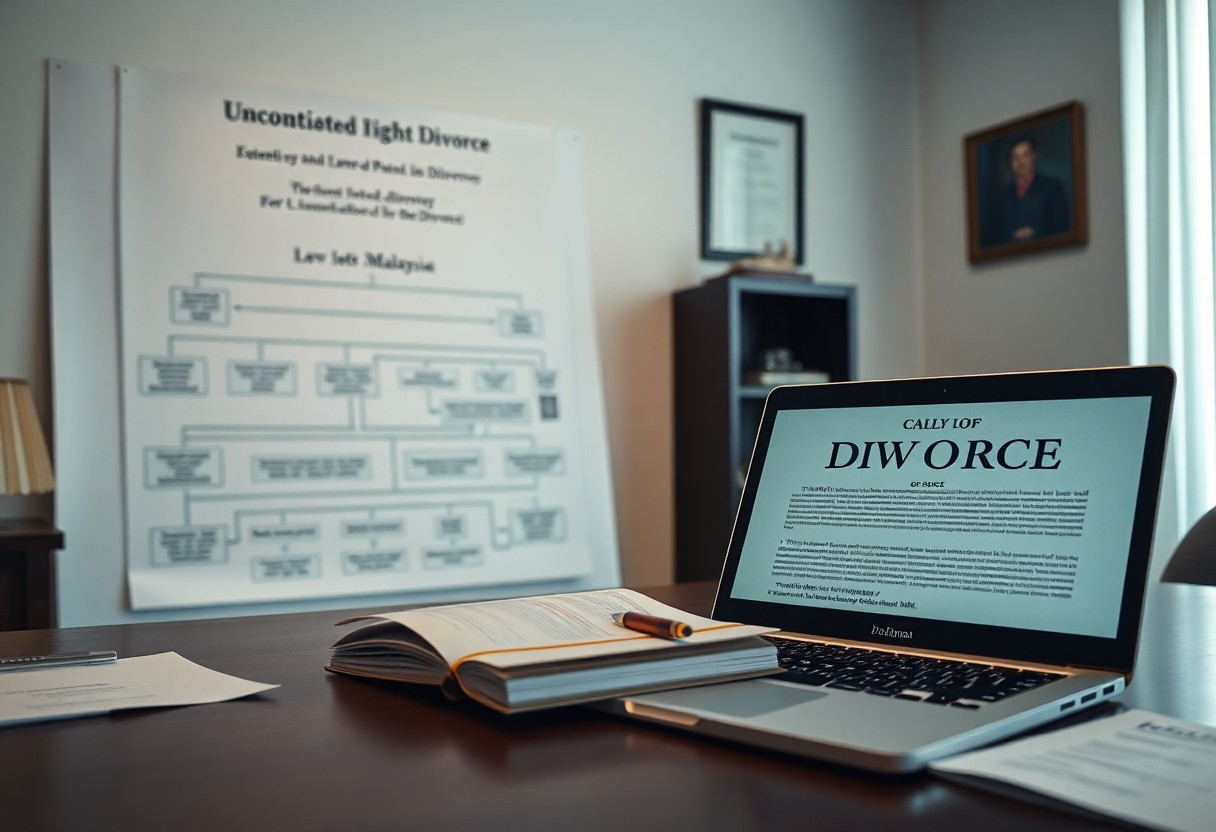Divorce can be a challenging process, but an uncontested divorce in Malaysia offers a simpler pathway for couples who mutually agree on the terms. This guide will walk you through the necessary steps to initiate and complete your uncontested divorce, ensuring you understand the legal requirements and benefits involved. By following this straightforward process, you can minimize stress and reduce costs, allowing you to move forward with your life efficiently.

Key Takeaways:
- Understand the grounds for uncontested divorce, primarily mutual consent.
- File a divorce petition at the relevant family court.
- Complete the necessary forms, including the Divorce Petition and Joint Affidavit.
- Prepare and submit supporting documents such as marriage certificates and financial statements.
- Schedule and attend a court hearing where consent and arrangements are discussed.
- Obtain a divorce order upon successful court approval.
- Consider seeking legal advice to ensure proper adherence to the process.
Navigating the Legal Landscape of Uncontested Divorce
Understanding the legal landscape of an uncontested divorce ensures a smoother process for you. Malaysia’s legal system offers specific provisions that facilitate this type of divorce, allowing for a quicker resolution without the animosity often associated with contested cases. Familiarizing yourself with these regulations, such as the role of the Court in approving your divorce application, helps in avoiding complications that may arise throughout the proceedings.
Key Legal Provisions Relevant to Divorce in Malaysia
The Law Reform (Marriage and Divorce) Act 1976 governs divorce proceedings in Malaysia, outlining the necessary steps and grounds for dissolution. An uncontested divorce typically requires both parties to agree on crucial issues such as child custody, division of assets, and maintenance, streamlining the process considerably. Significant attention should be paid to ensure compliance with legal requirements to avoid delays.
Essential Documentation and Legal Requirements
Filing for an uncontested divorce demands specific documentation, including the Divorce Petition, a Marriage Certificate, and any agreements related to child custody and asset division. You must also submit a Statement of Claim, affirming that both parties consent to the divorce and have reached a mutual agreement on all relevant matters. Each document needs to be correctly filled to meet the Court’s expectations.
Gathering and preparing crucial documentation is vital for your uncontested divorce. Your Divorce Petition must include comprehensive details about your marriage, including the date of marriage, separation, and grounds for divorce. The Marriage Certificate is crucial for verifying your marital status, while any settlement agreements you have reached regarding children and property need to be clearly documented and signed by both parties. Ensuring precision in these documents not only expedites the process but also reduces the risk of potential rejection by the Court, making the overall experience less daunting.

The Preparing Stage: Building a Strong Case for Uncontested Divorce
Preparation is key in ensuring your uncontested divorce proceeds smoothly. This phase involves gathering all necessary documentation and establishing clear agreements on financial and custodial matters. A well-prepared case not only streamlines the process but also minimizes potential conflicts that might arise later. Taking time to organize your information will support a favorable outcome that respects both parties’ needs and rights.
Gathering Necessary Financial and Custodial Data
Collecting comprehensive financial and custodial information is important. This includes documents such as bank statements, property deeds, income tax returns, and any agreements related to child custody and support. By doing so, you create a transparent overview of your financial situation, allowing both parties to identify fair settlements and arrangements that reflect your obligations and rights.
Handling Asset Division Equitably
Asset division requires careful consideration to ensure both parties feel satisfied with the outcomes. Begin by listing all marital assets, including property, bank accounts, and shared debts. Ideally, both individuals discuss and agree on an equitable distribution that reflects each party’s contributions and future needs. Utilizing mediation can aid in balancing interests and fostering a collaborative environment.
Equitable asset division isn’t about splitting assets down the middle; it involves recognizing each partner’s contributions, both financially and non-financially, throughout the marriage. For instance, if one partner stayed home to raise children, that contribution holds significant value despite not being a direct financial input. You might consider factors such as each individual’s earning potential, any existing debts, and personal circumstances, ensuring a fair process rooted in mutual agreement. Making these considerations helps maintain amicable relations during a challenging time.

Drafting the Divorce Agreement: The Blueprint for a Smooth Process
Creating a comprehensive divorce agreement is vital for ensuring both parties are on the same page. This document serves as a blueprint, outlining key aspects such as asset division, child custody arrangements, and spousal support. By addressing these elements clearly, you minimize the likelihood of disputes arising later, facilitating a faster and more amicable divorce process. An effective agreement reflects the unique circumstances of both parties while adhering to Malaysian legal requirements.
Essential Elements of an Uncontested Divorce Agreement
Your uncontested divorce agreement should encompass several necessary elements, including the division of marital assets, debts, custody arrangements for children, visitation rights, and child support details. Be explicit about how assets will be split and how joint debts will be handled. Addressing these issues clearly prevents conflicts and sets a solid foundation for post-divorce interactions, particularly regarding any children involved.
Common Pitfalls to Avoid When Drafting
Avoid vague language and incomplete provisions in your divorce agreement to ensure clarity and enforceability. Failing to adequately address potential future changes, such as relocation or changes in financial status, can lead to disputes later. Engaging a legal professional to review your agreement can help you sidestep these common traps and craft a document that protects your interests.
Many overlook specific details that can complicate later proceedings, such as property valuations or the tax implications of asset transfers. Ensure all financial assets, including retirement accounts and investments, are accurately valued and described in the agreement. Additionally, consider including a clause to modify terms as circumstances change, which can help you avoid having to go back to court in the future. Anticipating these issues and addressing them proactively can save you time and stress later on.
The Court Submission Process: Ensuring a Seamless Experience
The court submission process is a pivotal step in your uncontested divorce journey. Proper adherence to procedural requirements can greatly facilitate a smooth experience. Ensuring all documents are accurately filled and submitted on time prevents delays and reduces the likelihood of complications. Familiarize yourself with the local court’s guidelines and maintain an organized filing system to streamline your experience.
Step-by-Step Guide to Filing Your Application
Filing your application requires attention to detail. Follow this structured approach to ensure accuracy:
Filing Process Steps
| 1. Prepare Required Documents | Ensure all necessary documents, like the divorce agreement and certificate of marriage, are ready. |
| 2. Complete the Divorce Petition | Fill out the divorce petition form accurately, providing all required details. |
| 3. Submit to the Court | File your documents at the relevant court, paying the required fees. |
| 4. Serve the Documents | Provide copies of the filed documents to your spouse, ensuring they receive them. |
| 5. Await Court Hearing Date | Monitor your application for a scheduled hearing date and confirmation. |
What to Expect During the Hearing
During the hearing, you can expect a brief and straightforward process, primarily focused on confirming the details of your divorce agreement. The judge will review your submitted paperwork and may ask both parties a few questions. You are encouraged to present your case clearly and respectfully.
Typically, the hearing lasts only a short duration, often around 15 to 30 minutes. The judge will aim to ensure that both parties understand the terms of the divorce agreement and that there are no remaining disputes. Being prepared to articulate your agreement and having all relevant documents accessible fosters a positive environment, enabling a swift resolution to your divorce proceedings.
Post-Divorce Considerations: Moving Beyond the Legalities
Transitioning from married life to independence presents unique challenges. Beyond the legal dissolution of marriage, you must navigate new dynamics in your daily life, including emotional adjustments and practical arrangements. Understanding your rights and responsibilities post-divorce will empower you to take proactive steps in building a fulfilling future while maintaining stability for children and other dependents.
Handling Child Custody and Support Agreements
Your child custody and support agreements will significantly impact your child’s well-being. Clear communication with your ex-spouse about visitation schedules, educational needs, and financial responsibilities fosters a cooperative co-parenting relationship. Document these agreements thoroughly to avoid misunderstandings and ensure compliance, prioritizing the interests of your child above all else.
Strategies for Emotional and Financial Recovery
Rebuilding after divorce involves addressing both emotional and financial health. Engaging in therapy or support groups provides imperative outlets for processing feelings, while creating a strict budget can help manage any financial changes. Securing new employment or enhancing skills through education may pave the way for future stability and growth.
Establishing a solid support system is paramount for emotional recovery. Surround yourself with family and friends who encourage you, allowing you to share your experiences and feelings. Financially, reassessing and adjusting your lifestyle can help you regain control over your finances. Creating a savings plan and avoiding impulsive spending aids in achieving long-term stability. Additionally, exploring new hobbies or re-engaging in old interests can foster joy and purpose during this transitional period.
To wrap up
Following this step-by-step guide to uncontested divorce in Malaysia, you now have a clear pathway to navigate the process efficiently. By understanding the necessary documentation, legal requirements, and court procedures, you can ensure a smoother transition during this challenging time. Be diligent in collecting all relevant information and seek legal advice as needed to protect your interests and rights. With careful preparation, you can achieve a resolution that aligns with your goals and paves the way for your future.
FAQ
Q: What is an uncontested divorce?
A: An uncontested divorce occurs when both parties agree on the terms of the dissolution of marriage, including issues like asset division and child custody, without needing court intervention for disputes.
Q: What are the requirements for filing an uncontested divorce in Malaysia?
A: The requirements include one party being a Malaysian citizen or resident, the marriage having lasted at least two years, and both parties mutually agreeing on divorce terms.
Q: What documents are needed for an uncontested divorce?
A: Required documents typically include a petition for divorce, marriage certificate, identity cards, and any agreements related to child custody and asset division.
Q: How long does the process take for an uncontested divorce?
A: The process generally takes between 3 to 6 months, depending on the court’s schedule and the completeness of the submitted documents.
Q: Can I represent myself during the uncontested divorce process?
A: Yes, individuals can represent themselves, but consulting a lawyer is advisable to ensure all legal requirements and documents are correctly handled.
Q: How is the division of assets handled in an uncontested divorce?
A: Asset division is determined mutually by both parties through an agreement, which is then submitted to the court for approval as part of the divorce process.
Q: Is it necessary to attend court for an uncontested divorce?
A: Yes, both parties must attend court for a final hearing to finalize the divorce, where the judge will review the submitted documents and agreement.
